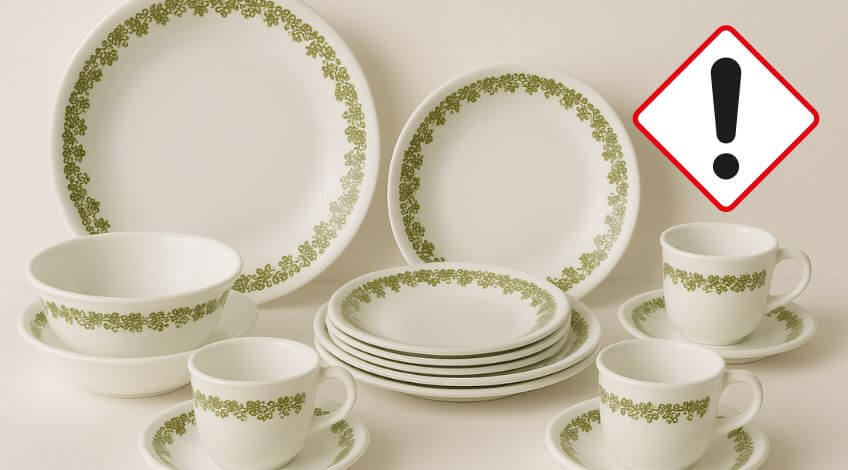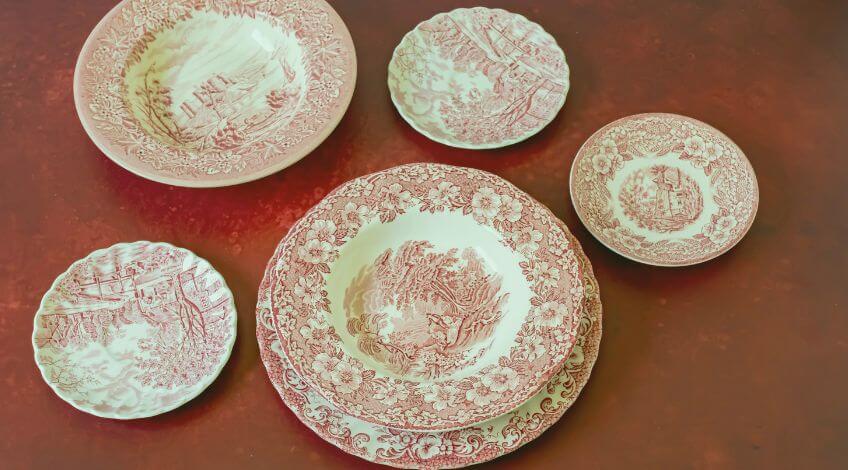
If You Own Vintage Corelle Dinnerware, Read This Before Your Next Meal!
Got a cupboard full of those gorgeous vintage Corelle plates with the iconic butterfly patterns? Or perhaps you’ve lovingly kept your mum’s Spring Blossom Green (aka “Crazy Daisy”) collection that reminds you of Sunday roasts from your childhood? We totally get it! Those vintage Corelle dishes aren’t just kitchenware, they’re proper time machines that transport us back to simpler days!
But before you serve up your next shepherd’s pie on that retro dinnerware, there’s something all of us vintage kitchen enthusiasts should know about our beloved plates. And don’t worry, we’re not here to spoil your collector’s joy, just to make sure you can enjoy those nostalgic treasures safely!
What’s Hiding In Your Kitchen Cupboard?
Let’s be honest, almost everyone has encountered Corelle at some point, right?
These nearly indestructible dishes became kitchen staples after hitting the scene in the 1970s. Remember how your gran would boast they’d “never break” (before accidentally dropping one and watching it shatter into a million tiny pieces)? Their legendary durability is exactly why so many of us still have them knocking about in our kitchens today!
But here’s the thing about those charming vintage patterns that collectors go mad for… they were made long before today’s safety standards came into play. And that’s something worth chatting about if you’re serving your Sunday roast on them!
The Not So Pretty Part Of Pretty Patterns
So here’s the slightly awkward bit. Those lovely decorative patterns on older Corelle dishes could contain lead in the paint.
Back before the 1980s, regulations weren’t as strict about what manufacturers could use in their decorative paints. Corelle wasn’t alone in this, loads of dishware brands used these materials because, well, that’s just what everyone did back then!
The potential issue comes when that paint starts showing its age, chipping off or wearing away after decades of loyal service. If you’re using damaged vintage dishes, there’s a chance that some of that old paint could mix with your food. Not exactly the kind of “secret ingredient” anyone’s after, is it?
Lead isn’t something you want in your beans on toast, especially if you’ve got little ones in the house. Children are particularly sensitive to lead exposure, but it’s not brilliant for adults either! While you’re unlikely to get seriously ill from occasional use of an old plate, regular meals on deteriorating vintage patterns might be something to rethink.
Corelle’s Own Advice Might Surprise You!
Here’s the eyebrow raising bit. Corelle themselves actually suggested that any of their dishes made before 2005 should be kept for display purposes only! Yes, you read that right, 2005, not just the really old stuff from the 70s and 80s. That’s quite the bombshell for those of us with “vintage” collections that aren’t actually that ancient!

This puts collectors in a bit of a pickle, especially if you’ve built your kitchen aesthetic around those gorgeous retro patterns! Do you really have to stop using your beloved Butterfly Gold plates that have faithfully served thousands of meals?
Must You Stick Your Fab Dishes In A Cabinet Forever?
Not so fast! Before you panic and pack away all your vintage treasures, let’s get practical about this.
First off, anything bought after 2005 is absolutely fine, so your newer Corelle purchases can stay right where they are. Phew!
For the older dishes, it really comes down to their condition and how you use them. If your vintage plates are showing obvious signs of wear and tear, with faded or chipping patterns, they’re probably best retired from food duty. Think of it as a well deserved promotion to display status after years of faithful service!
But if your vintage collection still looks brilliant (Corelle is famously durable, after all), there are plenty of ways to keep enjoying them with a few sensible precautions:
- Perhaps skip serving piping hot curry or stews on them, as heat can potentially accelerate any leaching
- Maybe don’t zap them in the microwave (which is good advice for anything with metallic decorations anyway!)
- Try not to store leftover lasagne in them for days on end
- Use plain white vintage Corelle for everyday meals, saving the decorated pieces for less frequent use
It’s all about being sensible rather than scared!
Checking If Your Collection Is Safe
Wondering if your gorgeous vintage Corelle set might be harbouring unwanted extras? You can always pick up a lead testing kit online or from most DIY shops. They’re fairly straightforward to use, though they work better for detecting higher levels of lead rather than tiny traces.
For collectors who love the hunt, this might even add an interesting new dimension to your vintage shopping, testing pieces before they earn a spot in your collection!
Enjoying The Best Of Both Worlds
For serious kitchenware collectors, this is about finding that sweet spot between appreciating the aesthetic brilliance of vintage designs and keeping your family meals safe.
Many collectors have found creative ways to enjoy their vintage Corelle without worry. Some use their most precious pieces as kitchen wall art, creating stunning displays that celebrate these design classics. Others keep a “special occasion” set of vintage dishes for serving less messy, room temperature foods like sandwiches or biscuits.
Meanwhile, you can still enjoy the practical benefits that made Corelle famous, like its impressive lightness and durability, by incorporating some newer patterns into your everyday rotation. Modern Corelle offers plenty of designs that capture vintage vibes while meeting all current safety standards, giving you the best of both worlds!
Clever Ideas For Vintage Corelle Lovers
If you’ve just discovered your treasured collection falls into the “maybe display only” category, don’t despair! Here are some brilliant ways to keep enjoying those vintage patterns:
- Use them for serving dry snacks like crisps or biscuits at your next get together
- Create a stunning kitchen display wall, showing off those amazing retro patterns
- Bring them out for special occasions where they’ll be used briefly (but perhaps not for Aunt Mabel’s notoriously hot curry!)
- Take gorgeous photos of your collection and have them printed on tea towels or modern dishes for a unique twist
- Keep your eyes peeled for post 2005 Corelle with vintage inspired designs for everyday use
For collectors who adore both the look and the history of vintage kitchenware, modern Corelle offers some lovely options that capture that retro charm. Their Winter Frost White range gives you that classic look without any safety worries!
What About Your Other Vintage Dishes?
This isn’t just a Corelle thing, by the way. If you’re a collector of any colourful vintage kitchenware from that era, similar considerations apply. Those charming hand painted serving platters and vibrant mid century dishes might benefit from the same thoughtful approach.
The good news is, being a vintage kitchenware enthusiast doesn’t mean giving up your passion! It’s simply about making informed choices about how you incorporate these treasures into your home. Displaying vintage pieces while using newer items for everyday meals offers a perfect balance for many collectors.
So before your next dinner party, take a quick inventory of your dinnerware collection. Your gorgeous vintage Corelle pieces tell a fascinating story of design history and family traditions, now you can make sure that story continues with a happy ending!
Would you use your vintage Corelle for display only, or do you think the concerns are overblown? We’d love to hear how you’re enjoying your retro kitchen treasures!
If this helped you, share it with a friend or send it to your family group chat. It might just save someone from an unwanted surprise at their next meal!
SEE ALSO: How to Get Rid of That Weird House Smell No One Talks About
Also, follow us on Pinterest ...
